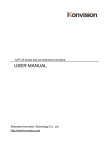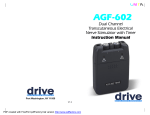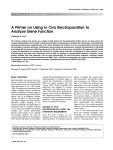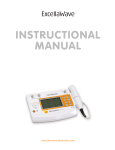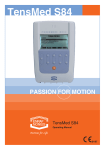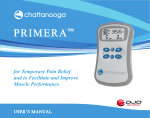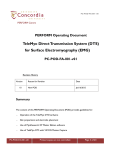Download Neurotrac TENS user manual
Transcript
NeuroTrac™ TENS Operation Manual
NeuroTrac™ TENS
DUAL CHANNEL TENS UNIT
Operators Manual
Visit our website: www.veritymedical.co.uk
for detailed application protocols
English
1
NeuroTrac™ TENS Operation Manual
Warnings
*
*
*
*
*
*
*
*
*
*
*
*
*
This unit must be used with the guidance of a Physiotherapist or
Doctor.
Type BF equipment, Continuous Operation.
Do not insert lead wires into a mains power supply.
Do not immerse unit into water or any other substance.
Do not use the NeuroTrac™ TENS unit in the presence of a
flammable anaesthetic gas mixture and air or with Oxygen or Nitrous
Oxide.
If using rechargeable 9 Volt PP3 Nickel Metal Hydride batteries, be
sure to use a CE approved battery charger. Never connect the
NeuroTrac™ TENS directly to a battery charger or to any other
mains powered equipment.
We advise not to use Ni-Cad rechargeable batteries.
Patient Electrodes are for single patient use only.
Keep out of reach of children.
Do not use this stimulator on your facial area unless you are under
strict guidance from a qualified Clinician.
Application of electrodes near the thorax may increase the risk of
cardiac fibrillation.
Operation in close proximity (e.g. 1m) to a shortwave or microwave
therapy equipment may produce instability in the stimulator output.
Simultaneous connection of a patient to a high frequency surgical
equipment may result in burns at the site of the stimulator electrodes
and possible damage to the stimulator.
No modification of this equipment is allowed!
Symbols on the rear cabinet of NeuroTrac™ TENS explained:
Caution
(output)
Type BF
Equipment
Follow
instructions
for use
Do not dispose in normal
dustbin (see page 18 for
the disposal instructions)
Revised Issue Date: 25/10/2011 Document Number: VM-ECS300-OM002-18
2
NeuroTrac™ TENS Operation Manual
Contents
Contents:
Page:
Warnings
Intended Purpose
What is Pain?
What is TENS?
Contra Indications & Precautions
Description of TENS Unit & Functions
Quick Start Instructions
Programmes
Lock Mode Function
Using the NeuroTrac™ TENS Unit
Treatment Modes
How Long do I Use TENS For?
Electrode Placement
Dermatomes & Myotomes
Contiguous Placement
Acupuncture Points
Electrode Types & Tips
Suggested Electrode Placement
Care, Maintenance, Accessories and Disposal
Conditions Respond to TENS
Commonly Asked Questions
Specifications
Information regarding Electromagnetic compatibility
and interference (EMC)
Warranty
Dermatome Charts
Clinical References
2
4
4
4
5
6
7
8
9
10
11
11
12
12
12
12
13
14
18
19
20
21
3
22
25
26
28
NeuroTrac™ TENS Operation Manual
Intended Purpose
TENS uses a small battery operated unit to provide a non-invasive, drug free
method of controlling acute and principally long term intractable pain. It can
also be used as adjunctive treatment in the management of post surgical
traumatic pain problems. Mild electrical impulses are transmitted through the
skin via surface electrodes to modify the body's pain perception.
What is Pain?
When we feel pain it is the body’s process of informing us that something is
wrong. To feel pain is important, without this feeling abnormal conditions may
go undetected, creating damage or injury to critical parts of the body.
Although pain is essential in warning our body of trauma or malfunction,
nature may have gone too far in its design. Continued long-term chronic pain
has no useful value apart from its importance in diagnosis. Pain begins when a
coded signal travels to the brain where it is decoded, and analysed. The pain
message travels from the injured area of the body along small
diameter nerves leading to the spinal cord. At this point the message is
switched to a different kind of nerve that travels up the spinal cord to the brain
area. The brain then analyses the pain message, refers it back and the pain is
felt.
What is TENS?
Transcutaneous Electrical Nerve Stimulation (TENS) uses a small battery
operated unit to provide a non-invasive, drug free method of controlling acute
and principally long term intractable pain. It can also be used as an
adjunctive treatment in the management of post surgical traumatic pain
problems. In TENS mild electrical impulses are transmitted through the skin
via surface electrodes to modify the body’s pain perception. TENS does not
cure problematic physiological conditions; it only helps to control the pain
perception. TENS will not work for every user. Please seek advice from your
Doctor.
There are millions of small nerve fibres throughout the body and it only
requires a few impulses to produce chronic pain. In addition to small fibres,
which allow the sensation of pain to be felt, the body is also made up of larger
diameter nerve fibres. These larger nerve fibres transmit less unpleasant
sensations such as touch or warmth, assisting us to form an impression of our
environment. Stimulating the larger nerve fibres using TENS may have the
effect of inhibiting the transmission of pain along the smaller nerve fibres to the
spinal cord [known as the ‘Pain Gate Theory’].
4
NeuroTrac™ TENS Operation Manual
Contra Indications & Precautions
Before using this equipment you must first seek the advice of your
Physiotherapist or Doctor.
Read this operating manual before using the TENS unit
TENS should not be used:
*
*
*
*
*
*
*
*
*
*
*
*
*
*
By patients fitted with a demand style cardiac pacemakers unless so
advised by their Doctor.
During pregnancy [unless medically advised].
By patients with undiagnosed pain conditions.
By patients with undiagnosed skin conditions.
With patients who have diminished mental capacity or physical
competence who cannot handle the device properly.
On anaesthetised or desensitised skin.
When driving a vehicle or operating potentially dangerous
equipment.
Do not place electrodes:
> Over cartoid sinus nerves.
> Over larynx or trachea.
> Inside mouth.
> Over the area of the heart unless so advised by your Doctor.
> On your facial area unless under strict guidance from a
qualified Clinician.
The patient should use the unit only as prescribed.
Do not immerse the unit in water or any other liquid.
If you experience skin irritation this may be due to over-stimulation.
In this case leave the skin to heal and use TENS only for the periods
prescribed. Turning the current up too high can cause skin irritation.
In this case allow the skin to heal and use TENS at a lower intensity.
Some people experience an allergic reaction to the adhesive coating
on the surface of the electrode. If this happens use a different make
of electrode or change the electrode. If it continues try reducing the
pulse width. If the problem still persists try moving the electrode
position each day by just the width of the electrode, making sure the
electrode positioning is still over the dermatome.
Keep unit out of reach of children.
Only use CE approved skin electrodes.
If in doubt about the use of the NeuroTrac™ TENS unit, call your
Doctor, Therapist, Clinician or you distributor for advice.
5
NeuroTrac™ TENS Operation Manual
Description of TENS Unit & Functions.
Channel A
Channel B
LCD
Display
Lead
Wire
and Pin
Select
Programme
NeuroTrac ™
TENS
SET
ESC
Front
Rear
* PRG button
Selects the desired set programme from P01 - P11 or
customised programme PC1 - PC3.
* SET button
Displays the menu and changes the parameters for
Pulse Rate, Pulse Width and Time for custom
programmes.
* ESC button
Stores customised programme and returns to the
home position.
6
NeuroTrac™ TENS Operation Manual
Quick Start Instructions
1.
2.
3.
4.
5.
6.
Insert a 9 volt PP3 Alkaline battery. Alternatively insert a rechargeable
Nickel Hydride battery [Which is safer and has a much longer life than
the Ni-Cad rechargeable batteries] into the battery compartment.
Insert lead wire/s to channel A and B if both channels are to be used.
Switch on the unit by pressing the ON/OFF button
Press the PRG [Programme] button to select one of the programmes as
detailed in table 1 and table 2 on page 8.
To start press channel A + and B + button if you are using both
channels.
To stop the programme, press the ON/OFF button which will turn the
unit off.
Setting up your own continuous mode parameters for PC 1 or PC 2..
1.
Select PC1 or PC2 by pressing the PRG button on the front panel.
Remove the battery lid where you will see two buttons SET and ESC.
Press the SET button and the Hz symbol will flash, then press the +
or – button on the front panel to adjust the Pulse Rate (frequency)
from 2 - 200 Hz
2.
Press the SET button again and the μS symbol will flash, then press
the + or – button to adjust the Pulse Duration from 50 - 300 μS
Setting up your own Modulated mode paramters for PC3.
3.
Select PC3 by pressing the PRG button on the front panel.
Press the + or - button on the front panel to adjust the high pulse rate
(frequency) from 2 - 200 Hz.
4.
Press the SET button and F LO will display.
Press the + or - button on the front panel to adjust the low pulse rate
(frequency) from 2 - 200 Hz.
5.
Press the SET button and μS symbol will flash and W LO will display.
Press the + or - button on the front panel to adjust the high pulse
width from 50 - 300 μS.
6.
Press the SET button and W LO will display.
Press the + or - button on the front panel to adjust the low pulse
width from 50 - 300 μS.
7.
Press the SET button again and the Clock symbol will flash ON/OFF,
then press the + or – button to adjust the time. Channel A + or –
button to hours and Channel B + or – button to change minutes.
8.
After setting up the customised programme parameters, press the ESC
button to store the information. Simply repeating the above procedure
can reprogramme customised programmes.
Note: You must press the ESC button before locking the unit.
7
NeuroTrac™ TENS Operation Manual
Programmes
Table 1
Programme
M ode
P1
P2
P3
P4
P5
P6
P7
P8
Con Con
Con
C on
Con Con MP / MF
MF
4 hr 4 hr
4 hr
4 hr
4 hr
2 hr
Puls e Rate
Hz
Puls e
Width μS
Time
4 hr
2 hr
Table 2
Programme
P9
P10
P11
PC1
PC2
PC3
M ode
Bst
A=Con
B=Bst
MF
C on
Con
MF / MP
2 hr
2 hr
35 min
Cust
Cust
Cust
Pule s e Rate
Hz
Puls e Width
μS
Time
8
NeuroTrac™ TENS Operation Manual
Lock Mode Function
Lock Mode Function
A "concealed" Lock button is included in the NeuroTrac™ TENS unit, which
allows the clinician to accurately monitor the "Home Compliance" of the
patient between appointments. The lock function allows the device to be
locked in two ways:- One {L:T} to measure the time in use over one hour, and
the average mA current used, leaving the parameters i.e. Constant, Burst,
Modulation and the Rate and Pulse Width to be freely altered by the user or
alternatively {L:PT} Locking the device to measure, time, mA current used
and locking the parameters in place, which then cannot be changed or altered
by the patient during use.
Locking the Unit
Remove the battery cover and, using the end of the lead wire, gently press on
the concealed lock button as shown in the diagram on page 6 until you hear a
double bleep. {L:T} Lock time and Current will appear on the LCD screen. If
you want to lock the parameters as well press the +/- button until {L:PT}
appears. Press the ESC button to lock parameters in place.
0mA
L:T
0mA
0mA
L:PT
0mA
Ch.A
Ch.B
Ch.A
Ch.B
To Unlock the Unit
To unlock the unit and display the lock information, remove the battery cover,
using the end of the 2mm dia pin press the concealed switch once and you will
here a single bleep, this indicates the unit is now unlocked. The information for
time in use and the average m A current used can be read on the front of the
LCD display as seen on the diagram below. When you have noted the
information press the ESC button to bring the unit back to the Home position.
Hours
45
20 mA 20 mA
Ch.A
Ch.B
9
NeuroTrac™ TENS Operation Manual
Using the Neurotrac™ TENS Unit
RATE [Hz or pulses per second]
The RATE to be selected depends primarily on the electrode placement on the
patient’s body. If one uses contiguous and dermatome (the electrodes alongside
or over the area of pain) electrode placement, a higher rate of 80 Hz –100Hz is
desirable. The patient should experience steady continuous stimulation. It has
been found that an optimal setting of 80 or 90 Hz with a pulse width of 200μS
has good effect for most patients and is a good first choice for pain-gating.
Patients using Trigger, motor or acupuncture points tend to respond to low rate
stimulation 2 Hz-10 Hz and pulse width of 200μS. The desired effect is for the
patient to feel individual pulses.
PULSE WIDTH [Duration]
The wider pulse widths will deliver stronger stimulation for any given
intensity [mA] setting. By using a combination of intensity and pulse
duration, it is felt that various pulse widths are capable of stimulating
different groups of nerve fibres. The wider pulse duration is needed to recruit
motor fibres, where as the narrow pulse duration is used more on the sensory
fibres.
The selection of which pulse duration to use is dependent upon the intended
treatment protocol.
Stimulating the larger nerve fibres is thought to reduce the speed and the
amount at which information is transmitted along the smaller nerve fibres. Also
under certain circumstances the brain is thought to produce its own
analgesic pain-killing substances, known as endorphins or endogenous opiates.
Intensity [mA]
Patients respond differently to the level of intensity, this is due to differences
in individual patient’s skin resistance, enervation and the type and condition of
electrode being used.
A good formula for setting the intensity is to increase the current so that the
patient feels slight muscle contraction, but not strong enough to move a joint,
and then slightly reduce the intensity so that it feels comfortable. When using
low rate TENS settings, individual twitches will occur. The higher rate TENS
settings will increase muscle tension. It is not advised to increase the intensity
to experience strong muscle contraction.
10
NeuroTrac™ TENS Operation Manual
Treatment Modes
There are three treatment modes available on the NeuroTrac™ TENS unit:
1. Conventional TENS or normal. This mode enables the user to select any
rate between 2 Hz – 200 Hz, and a pulse width between 50μS-300μS. This is
the most frequently used of the three modes. The most common selection is 80
Hz with a 200μS pulse width.
2. Burst Mode. This mode is comparable to the low rate TENS technique
except that each low rate pulse is substituted for by a short BURST of 9 pulses
[200μS] at 150 Hz. It is a combination of conventional and low rate TENS.
The burst mode is often referred to as acupuncture - like TENS.
3. Modulation TENS this mode was designed to help prevent nerve
accommodation that some patient’s experience. It is achieved by
continuously cycling the pulse width and rate.
How Long Do I Use TENS For?
This depends on the individual patient’s condition, accuracy of electrode
placement, stimulation and the characteristics selected, but typically the onset
of pain relief starts after 20-30 minutes. Generally TENS is used for longer
periods of normally 1 hour 30 minutes per session. With some patients it can
be much longer.
11
NeuroTrac™ TENS Operation Manual
Electrode Placement
The placement of electrodes is one of the most important parameters in
achieving effective pain relief using TENS. This is best left to your
Physiotherapist or Doctor to advise as to which location is most appropriate. It
may transpire that various positions need to be experimented with before the
user finds the most effective positioning. The positioning may be via the
contiguous, dermatome, myotome, motor, trigger or acupuncture points.
Dermatomes & Myotomes
These are areas of the body enervated by a single nerve root via the spinal cord.
Each nerve root serves a known area of the skin. The dermatomes are named
after the nerve root which serves it. For details of dermatome sites refer to
diagrams on pages 26 & 27.
Contiguous Placement
This form of electrode placement is the most common method used. It
involves placing the red lead [proximal] alongside the spine where the
dermatome [on which your pain lies] enters and exists. The black lead [distal]
is normally placed over or near to the pain site. Your Physiotherapist or
Doctor may direct the current to cross through the pain area or using the
‘bracket’ system allow the current to flow on either side of the pain site
through the nerve branches that supply the pain location.
Acupuncture Points
The placement of the red and black electrodes on the skin forms the electrical
circuit for TENS. It is the skin itself that creates the highest electrical
resistance to stimulation. The Physiotherapist or Doctor may consider using
acupuncture loci, which offer much lower resistance properties, as a more
effective site for placing the electrodes.
Accurately locating an acupuncture point can be difficult, please seek advice
from your Doctor or Physiotherapist.
12
NeuroTrac™ TENS Operation Manual
Electrodes Types and Tips
*
Self-Adhesive reusable long-term electrodes have a typical life span
(if looked after) of 4/6 weeks. We recommend cleaning the skin before
placing the electrodes. After use place the electrodes back onto the
plastic film and in the zip-tag plastic pouch. Store in a cool
environment.
Skin Electrode Types Available:
SHAPE
CODE
DESCRIPTION
VS.4040
40 x 40 mm, square [** max 53mA]
VS.5050
50 x 50 mm, square
(recommended for general use)
VS.9040
90 x 40 mm, rectangular
VS.9050
90 x 50 mm, rectangular
VS.10050 100 x 50 mm, rectangular
VS.30
30 mm diameter, round
[** max 46mA]
VS.50
50 mm diameter, round
** IMPORTANT : Don’t use VS 4040 at more than 53mA
and VS3030 at more than 46 mA.
A Few Good Tips [Self- Adhesive Electrodes]
*
*
*
If you find the electrodes will not stick due to oily skin, cleanse the
skin with soap and water, then rinse and dry the area around the
electrode site. If this does not work, try cleansing the skin with a swab
impregnated with alcohol.
Clip away hairy skin using scissors; don’t use a razor
to remove the hairs!
The electrodes conductive material is water- based. If it becomes
saturated (e.g. from perspiration), it will lose its adhesive qualities.
After use leave the electrodes face up overnight to dry out (replace on
plastic film in the morning).
At some point the electrodes will become dry. Moisten the adhesive
surface with a few drops of water, and apply onto the plastic film
overnight. This procedure will increase the electrode life by few more
days.
13
NeuroTrac™ TENS Operation Manual
Suggested Electrode Placement
+ = Red
- = Black
Pain caused by Finger Arthritis
Pain caused by Knee Arthritis
Neuralgia of Trigeninus
1
Cervical (2 Positions)
14
2
NeuroTrac™ TENS Operation Manual
If you are using electrodes on your face, we recommend
you contact your physiotherapist or clinician for guidance
+ = Red
- = Black
Cephalalgia Overorbital
Mandibular Syndrome
Phantom Limb
Herpes Zoster
15
NeuroTrac™ TENS Operation Manual
+ = Red
- = Black
Back Pain
Menstrual Pain
1
Lumbar Pain (2 Positions)
Tooth Ache
16
2
NeuroTrac™ TENS Operation Manual
+ = Red
- = Black
Sciatic Pain (2 Positions)
1
2
Epicondylitis
Shoulder Pain
Feet Pain
Ankle Pain
17
NeuroTrac™ TENS Operation Manual
Care, Maintenance,
Accessories and Disposal
WARNING! Only medically approved accessories should be used!
CONTROL UNIT
*
Wipe the surface once a week with a damp cloth or antiseptic wipe
*
Do not use cleaning sprays or alcohol based cleaning solutions
*
Control unit disposal: please return to Verity Medical LTD or to the
appointed distributor.
ACCESSORIES
Battery:
*
To change the battery, open the battery door on the rear of the
control unit by pressing down on the raised rib pattern just below the
belt clip. Lift the battery out of the compartment. This is very easy
and can be done by the user.
*
Check periodically for any discharge from the battery
*
Remove battery completely from unit if not in use for any
extended period of time (typically one week)
*
Low battery indicator of 6.9 volts shown on LCD display, when
flashing change battery for a new one
*
Preferably use a PP3 alkaline battery
*
Battery disposal: please return to the supplier from whom
you’ve purchased it.
Lead Wires:
*
The lead wires should be handled carefully and never stretched, as this
can cause the stimulation to function below normal standards or not at
all
*
Examine lead wires before each treatment for loose connections or
damage
*
Avoid stretching and twisting the lead wires
*
Store the lead wires carefully after each use
*
Lead wires Disposal: please return to the supplier from whom
you’ve purchased them.
Self-Adhesive Electrodes:
*
Check the short connectors have not become separated from the
electrodes
*
Replace electrodes onto plastic film after use. If they drop onto the
floor debris will adhere to conductive gel rendering the electrodes
ineffective
18
NeuroTrac™ TENS Operation Manual
Electrode life can be considerably reduced by:
*
The type and condition of the skin
*
Deep seated moisturisers or make-up
For the Best Results:
*
*
Before each use cleanse the skin
After each use stick the pads on the shiny insert card and store in a
cool and dry place, such as the fridge. (not freezer).
Caution: Static electricity may damage this product
NOTE:
Only Verity Medical Ltd or appointed distributors /importers
are approved to undertake servicing.
Conditions that respond to TENS
Pain associated with
Arthritis
*
Period Pain
*
Cancer Pain
*
Post Operative Pain
*
Back Pain
*
Lumbago
*
General Pain
*
Pain due to Sports injury
*
Sciatica
*
Phantom Limb Pain
*
Muscular Shoulder
Aches
*
Skeletal Pains
*
Tension
*
following Amputation
*
Neuralgia
*
Whiplash
*
Pain associated with
Rheumatoid and
Osteo Arthritis
19
NeuroTrac™ TENS Operation Manual
Commonly Asked Questions
QA-
Does TENS work for all pain conditions and on all patients?
There is significant variation between patients with similar pain
conditions. However, it is known that TENS does work in up to 70%
of cases.
QA-
How can I have a better chance of success?
Seeking professional advice from your Physiotherapist or Doctor on
how to best apply TENS is the best answer we can give to this
question.
QA-
Are there circumstances in which TENS should not be used?
Yes. For undiagnosed pain; When using a cardiac pace maker;
During pregnancy and other instances as fully detailed in this manual
on page 5.
QA-
How long will I have to use the TENS stimulator?
Some long term chronic pain sufferers may have to use a stimulator
for extended periods of time, even years. Other conditions may only
need a short period of treatment lasting weeks.
QA-
If I have any medical or product queries how can I get help?
Any clinical advice on the TENS stimulator should be provided by
your Physiotherapist or Doctor.
20
NeuroTrac™ TENS Operation Manual
Specifications
TENS
1.
2.
3.
4.
5.
6.
7.
8.
9.
10.
11.
12.
13.
Dual channel: individually isolated circuits.
Amplitude: 0 - 80 mA into 500 Ohm load; indication only. Actual mA
will tend to be less than indicated due to electrode impedance: at
1000 Ohms load (Electrodes in poor condition) the maximum
will be limited to 70 mA, at 1500 Ohms load the maximum will be
limited to 65 mA.
Type: Constant Current,
maximum output voltage 180 Volts +10 / -30 Volts
Waveform: Asymmetrical, rectangular bi-phasic with zero DC
current.
Selectable pulse width: 50μS -300μS [2% accuracy].
Pulse Rate selection: in the continuous mode 2 Hz - 200 Hz
[2% accuracy].
Mode: Continuous, Burst or Modulated.
Burst mode: Bursts of 9 pulses [200 μS] at 150 Hz, repeating twice
every second.
Modulation mode: 6-second cycle of concurrent width
modulation and pulse repetition rate modulation. Width starting at
200 μS and decreasing exponentially to 100 μS in three seconds and
then returning back to 200 μS in the next three seconds. Rate starting
at 100 Hz, decreasing exponentially to 65 Hz and then returning to
100 Hz.
Time duration of the treatment selectable: 1 minute to 12 hours.
Low Battery Indicator: If the battery goes below 6.9 volts +/- 0.2
volts the battery symbol will flash on/off once every second.
If the battery voltage is below 6.6 (+/- 0.2) volts the unit will not turn
on.
Open Electrode Detect: If an open circuit is detected at the
output of channel A or B the output current will be reset at zero.
Physical dimensions: 108 x 62 x 23 mm.
Weight: 0.07KG without battery, 0.1KG with battery.
Environmental Conditions for use:
+10 to +30 degrees Centigrade. 0-90% Humidity.
Environmental conditions for storage & transport:
-10 to +50 degrees Centigrade. 0-90% Humidity.
21
NeuroTrac™ TENS Operation Manual
Information regarding Electromagnetic
compatibility and interference (EMC)
NeuroTrac™ products are designed to produce very low levels of radio
frequency (RF) emissions (interference), to be immune from effects of
interference produced by other equipment operating in their vicinity and
damage due to electrostatic discharge all when operating in a typical domestic
and or clinical environment. They are certified to meet the international EMC
standard EN60601-1-2. For more information please refer to the tables 201,
202, 204 and 206.
Table 201: Guidance and manufacturer’s declaration
– electromagnetic emissions
T he NeuroT racTM product is intended for use in the electromagnetic environment specified
below. T he customer or the user of the NeuroT racTM product should ensure that it is used
in such an environment.
Emissions te st
Compliance
Ele ctromagne tic e nvironme nt –
guidance
RF emissions
CISPR 11
Group 1
T he NeuroT racTM product uses RF energy
only for its internal function. T herefore,
its RF emissions are very low and are not
likely to cause any interference in nearby
electronic equipment.
RF emissions
CISPR 11
Class B
Harmonic emissions
IEC 61000-3-2
IEC 61000-3-2
Not applicable
Voltage fluctuations/
flicker emissions
IEC 61000-3-3
Not applicable
T he NeuroT racTM product is suitable for
use in all establishments, including
domestic establishments and those
directly connected to the public lowvoltage power supply network that
supplies buildings used for domestic
purposes.
Table 202: Guidance and manufacturers declaration
– electromagnetic immunity
T he NeuroT racTM product is intended for use in the electromagnetic environment specified
below. T he customer or the user of the NeuroT racTM product should ensure that it is used in
such an environment, and that precautions regarding that environment are heeded.
Immunity test
IEC 60601
te st le ve l
Compliance
le ve l
Electromagnetic e nvironme nt–
guidance
Electrostatic
discharge (ESD)
IEC 61000-4-2
±6 kV contact
±8 kV air
±6 kV contact Floors should be wood, concrete or
±8 kV air
ceramic tile. If floors are covered with
synthetic material, the relative
humidity should be at least 30 %.
Power frequency
(50/60 Hz)
magnetic field
IEC 61000-4-8
3 A/m
3 A/m
Power frequency magnetic fields should
be at characteristic levels of a typical
location in a typical commercial or
hospital environment.
22
NeuroTrac™ TENS Operation Manual
Table 204: Guidance and manufacturer’s declaration – electromagnetic immunity
T he NeuroT racTM product is intended for use in the elect romagnet ic environment specified below. T he customer or the
user of the NeuroT racTM product should ensure that it is used in such an environment .
Immunity te st
IEC 60601 te st le ve l
Compl iance
le ve l
3 Vrms
Conducted RF
3 Vrms
IEC 61000-4-6
150 kHz to 80 MHz
Radiated RF
IEC 61000-4-3
3 V/m
80 MHz to 2,5 GHz
150 kHz to 80
MHz
3 V/m
80 MHz t o 2,5
GHz
El e ctromagne ti c e nvironme nt – guidance
Portable and mobile RF communications equipment
should be used no closer to any part of the
NeuroT racT M product, including cables, than t he
recommended separation distance calculated from t he
equation applicable t o the frequency of the transmitter.
Re comme nde d se paration distance
d = 1.2 P (150 kHz to 80 MHz),
d = 1.2 P (80 MHz to 800 MHz),
d = 2.3 P (800 MHz to 2.5GHz),
where P is t he maximum out put power rating of the
t ransmitter in watts (W) according t o the t ransmit ter
manufacturer and d is the recommended separation
dist ance in met ers (m).
Field strengt hs from fixed RF t ransmitters, as
determined by an elect romagnet ic sit e survey,
(a) should be less than the compliance level in each
frequency range;
(b) int erference may occur in t he vicinit y of equipment
marked wit h the following symbol:
NOT E 1: At 80 MHz and 800 MHz, the higher frequency range applies.
NOT E 2: T hese guidelines may not apply in all situations. Electromagnetic propagat ion is affected by absorption and
reflect ion from structures, objects and people.
(a) Field st rengths from fixed transmitt ers, such as base st ations for radio (cellular/cordless) telephones and land mobile
radios, amateur radio, AM and FM radio broadcast and T V broadcast cannot be predicted theoretically wit h accuracy. T o
assess t he electromagnetic environment due t o fixed RF transmitt ers, an electromagnetic site survey should be
considered. If the measured field st rength in the location in which NeuroT rac TM product is used exceeds the applicable
RF compliance level above, t he NeuroT rac TM product should be observed to verify normal operat ion. If abnormal
performance is observed, addit ional measures may be necessary, such as reorienting or relocating the NeuroT rac TM
product.
(b) Over t he frequency range 150 kHz to 80 MHz, field strengths should be less t han 3 V/m.
23
NeuroTrac™ TENS Operation Manual
Table 206: Recommended separation distances between portable
and mobile RF communications equipment and NeuroTrac
TM
product
T he NeuroT racTM product is intended for use in an electromagnetic environment in which
radiated RF disturbances are controlled. T he customer or the user of the NeuroT racTM
product can help prevent electromagnetic interference by maintaining a minimum distance
between portable and mobile RF communications equipment (transmitters) and the
NeuroT rac TM product as recommended below, according to the maximum output power of
the communications equipment.
Rate d maximum output
powe r of transmitte r
W
Se paration distance according to fre que ncy of
transmitte r
150 kHz to
80 MHz
80 MHz to 800
MHz
800 MHz to 2,5
GHz
d =1.2 P
d =1.2 P
d = 2.3 P
0,01
0,1
1
10
0.12
0.38
1.2
3.8
0.12
0.38
1.2
3.8
0.23
0.73
2.3
7.3
100
12
12
23
For transmitters rated at a maximum output power not listed above, the recommended
separation distance d in meters [m] can be estimated using the equation applicable to the
frequency of the transmitter, where P is the maximum output power rating of the
transmitter in watts (W) according to the transmitter manufacturer.
NOT E 1: At 80 MHz and 800 MHz, the separation distance for the higher frequency range
applies.
NOT E 2: T hese guidelines may not apply in all situations. Electromagnetic propagation is
affected by absorption and reflection from structures, objects and people.
24
NeuroTrac™ TENS Operation Manual
Warranty
Verity Medical Ltd., provides a warranty to the original purchaser that this
product will be free from defects in the material, components and workmanship for a period of 2 years from the date of purchase [invoice date].
If Verity Medical Ltd., is satisfied that the product/s is defective the purchaser
may return this unit/s to Verity Medical Ltd., or the appointed distributor for
repair or replacement with a new unit. All returns must first be authorised by
Verity Medical Ltd., in advance. The liability of Verity Medical Ltd., under this
limited product warranty does not extend to any misuse or abuse such as
dropping or immersing the unit in water or other liquid substance or tampering
with the unit or normal wear and tear. Any evidence of tampering will nullify
this warranty.
Customer Service
Any queries should be addressed to:
Verity Medical Ltd.,
Unit 7, Upper Slackstead Farm
Farley Lane, Braishfield
Romsey
Hampshire SO51 0QL
United Kingdom
Tel.:
+44 (0) 1794 367 110
+44 (0) 1794 367 451
Fax:
+44 (0) 1794 367 890
E-mail:
Web:
[email protected]
www.veritymedical.co.uk
This product is manufactured by Verity Medical Ltd.,
in compliance with the European Union Medical Device Directive
MDD93/42/EEC under the supervision of SGS,
Notified Body number 0120.
Verity Medical Ltd., is certified by SGS to the following
Quality Standards:
ISO 9001:2008, ISO13485:2003.
25
NeuroTrac™ TENS Operation Manual
Dermatome Charts
Anterior View
26
NeuroTrac™ TENS Operation Manual
Posterior View.
27
NeuroTrac™ TENS Operation Manual
Clinical References
Conventional TENS:
Bates JAV, Nathan PW [1980] Transcutaneous electrical nerve
stimulation for chronic pain. Anaesthesia 35: 817-22
Ellis B [1995] Transcutaneous electrical nerve stimulators: outpatient
response to a temporary home loan programme Br J The Rehabil 2 [8]:
419-23
Frampton V, Bowesher D, eds. Pain Management by Physiotherapy.
Butterworth Heinemann, London: 115 –39
Hosobuchi Y, Adams J E, Linchitz R [1977] Pain relief by electrical stimulation of the central gray matter in humans and its reversal by naloxone. Science
197: 183 –186
Lundberg TMD. Et, al [1984] Physiotherapy Vol. 70 No. 3 98-100
Melzack R, Wall P D [1965] Pain mechanisms: a new theory. Science 150:
971 –979
Tulgar M, McGlone F, Bowsher D, Miles J B [1991b]Comparitive effectiveness of different stimulation modes in relieving pain: part II. A double blind
controlled long-term clinical trial Pain 4: 156-62
Walker J [1992] When self-help begins at home Prof Nurse 7 [10]: 662-4
28
NeuroTrac™ TENS Operation Manual
Notes
29
NeuroTrac™ TENS Operation Manual
30
NeuroTrac™ TENS Operation Manual
31
NeuroTrac™ TENS Operation Manual
Not for sale or use in the USA
Distributor:
Revised Issue Date: 25/10/2011 Document Number: VM-ECS300-OM002-18
32







































